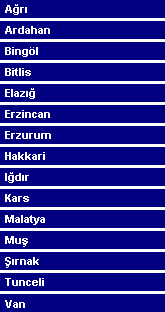| Bitlis... |
|
Bitlis stands in a narrow stream valley, just in the middle of a green oasis. Due to its location, it is an important
center for tobacco and honey production in eastern Türkiye. A Byzantine castle with polygonal towers dominates the town.
There are several mosques in the town, such as the Ulu Mosque of the 12th century and the Serefiye Mosque. The
city is surrounded by walnut trees, and if you are traveling through Bitlis in autumn, you will have the chance to buy
some of these delicious nuts from the children who sell them by the highway. Local folk dances of Bitlis are also very
famous. 25 kms northeast of the city, is the harbour town of Tatvan, from which there are passenger and train ferry
connections across the lake to Van. Mount Nemrut, is a perfect opportunity here for mountaineers and nature lovers (not
to be mistaken with the magnificent mountain of the same name, which has giant statues on top). This is an inactive volcano
with a deep, clear and cold crater lake, also having hot volcanic springs. Ahlat is a very important ancient center of
Turkish art and culture, located to the west of Lake Van (44 kms north of Tatvan). The town looks like an open air art
museum, with remains from various centuries and civilizations. The mausoleums from the Seljuk period, the Ulu Kumbet, Cifte
Kumbet, Baymdir Kumbet and Hasan Pasa Kumbet are several to be visited. Here are also artisticly carved monumental
tombstones from the 12th century which deserve the fame they have received. There are fine beaches and
restaurants in the town. 25 kms north of Ahlat, there is the ancient Urartian city of Adilcevaz where precious and
important remains have been found. The Ulu Mosque, on the shores of Lake Van, and the Kef Castle from the Seljuk period,
are to the west of Adilcevaz. The great Mount Suphan is, of course, the most attractive spot in Bitlis. You may climb
Suphan in summer when it is perfect for trekking. Some travel agencies have tours to Suphan. The lively city of Bitlis,
an important center of tobacco production, stands in the middle of a green oasis. The city's architecture uses the local
dark stone, and the masonry monuments include the Serefhan Medrese, the 12th century Ulu Mosque, the Seljuk
Gokmeydani Mosque, and the Ottoman Serefiye Mosque. Bitlis Ski center is close to the town's center. From Tatvan on the
western shore of Lake Van, you can take a passenger and train ferry across thewater to Van. Nemrut Dagi (Mount Nemrut)
makes a challenging climb. In its center a deep crater lake bubbles with volcanic hot springs.
|
|

|


 434...
434...
 13...
13...
 388,678...
388,678...
 6,707...
6,707...
 42 E 06 - 38 N 22...
42 E 06 - 38 N 22...









